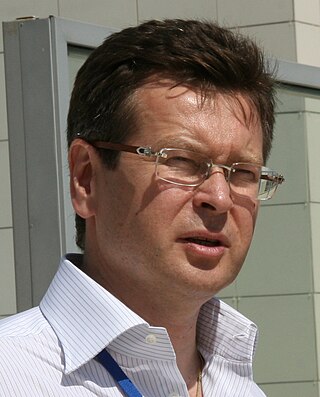History
Programme One was established on 22 March 1951 when, as part of a reorganization of the television system, the Moscow Television Station changed its name to reflect its planned expansion. It was known officially as the CT USSR Programme One (Russian: Первая программа ЦТ СССР).
The channel, which was transmitted on the SECAM D/K standard, carried advertising for the first time in the 1980s. The channel was broadcast until 1991. In September of that year, it was renamed as Central Television Channel One (Russian: Первый канал ЦТ), and then in December, following the dissolution of the USSR, became Ostankino Television Channel One.
Following the dissolution of the USSR, Programme One's frequencies were transferred to the new state broadcasting organizations in the former Soviet republics, while in the Russian republic the main Ostankino Television channel took over its signal and transmitters.
A television broadcaster or television network is a telecommunications network for the distribution of television content, where a central operation provides programming to many television stations, pay television providers or, in the United States, multichannel video programming distributors. Until the mid-1980s, broadcast programming on television in most countries of the world was dominated by a small number of terrestrial networks. Many early television networks such as the BBC, CBS, CBC, NBC or ABC in the USA and in Australia evolved from earlier radio networks.

Ostankino Tower is a television and radio tower in Moscow, Russia, owned by the Moscow branch of unitary enterprise Russian TV and Radio Broadcasting Network. Standing 540.1 metres (1,772 ft), it was designed by Nikolai Nikitin. As of 2022, it is the tallest free-standing structure in Europe and 12th tallest in the world. Between 1967 and 1974, it was the tallest in the world. The tower was the first free-standing structure to exceed 500 m (1,600 ft) in height. Ostankino was built to mark the 50th anniversary of the October Revolution. It is named after the surrounding Ostankino district of Moscow.

Television in the Soviet Union was owned, controlled and censored by the state. The body governing television in the era of the Soviet Union was the Gosteleradio committee, which was responsible for both the Soviet Central Television and the All-Union Radio.
Broadcasting in the Soviet Union was owned by the Soviet state, and was under its tight control and Soviet censorship. Through the development of satellites and SECAM, controlled broadcasting was initialized as the main frequency for distributing information and entertainment. Under the control of the Soviet Union, censorship and limitation on information was filtered for the citizens to ensure the common culture and socialist ideals were maintained.
Vremya is the main evening newscast in Russia, airing on Channel One Russia and previously on Programme One of the Central Television of the USSR. The programme has been on the air since 1 January 1968 and has broadcast in color since 1974.

The All-Russia State Television and Radio Broadcasting Company or Russian Television and Radio Broadcasting Company, also known as Russian Television and Radio, is a national state-owned broadcaster which operates many television and radio channels in 53 of Russia's languages. The company was founded in 1990 and is based in Moscow.
Russia-1 is a state-owned Russian television channel, first aired on 14 February 1956 as Programme Two in the Soviet Union. It was relaunched as RTR on 13 May 1991, and is known today as Russia-1. It is the flagship channel of the All-Russia State Television and Radio Company (VGTRK).

Public Television of Armenia, also known as AMPTV or ARMTV, is an Armenian public television station that began transmissions in 1956.

Minuta Molchanya known for its full title as To the Bright Memory of the Fallen in the Fight Against Fascism was an annual simultaneous broadcast aired at 18:00 UTC annually on 9 May dedicated to the victims of Great Patriotic War. It broadcast public events on all radio and television stations across Russia and ex-USSR during its Victory Day yearly. It was first broadcast on Soviet Central Television in 1965, 20 years after the Allied victory over Nazi Germany.

VID, stylized as ВИD, lit. "View"; acronym of VzglyadiDrugiye, "Outlook and Others", formerly VIDgital from 2017 to 2020, is a Russian and former Soviet TV production company. VID produces shows for Channel One Russia, NTV and OTR. It is best known for producing the television programmes Wait for Me, designed to help people find loved ones and Pole Chudes which is a popular Russian version of Wheel of Fortune.

Vladimir Nikitovich Maslachenko was a Soviet and Russian footballer and football commentator.

TV Centre is a Russian public television station with the fourth largest coverage area in Russia, after Channel One, Russia-1 and NTV. It is owned by the administration of the city of Moscow and is dedicated to programming that highlights various aspects of Moscow life. The channel airs across Russian territory.
The Central Television of the USSR was the state television broadcaster of the Soviet Union.

Pesnya goda, meaning Song of the Year, is an annual televised music festival and gala in Russia, honoring standout songs from the previous year. The event began in the Soviet period, and prior to the dissolution of the USSR also included songs in languages other than Russian.
Programme Two was one of the channels of Soviet Central Television between 1956 and 1991. Its programmes was mostly entertainment, cultural, news and sport programming. It was also known as the All-Union Program due to its national reach across the Soviet Union and the fact that even programs of all forms from the various Union republics were also broadcast here. It is now known as Russia-1.
The Moscow Programme was a television channel in the Soviet Union. It had a political focus and discussed events in Moscow. Now it is a television station broadcast by the Moscow City Government named TV Centre.
The All-Union First Programme was a radio channel in the Soviet Union. It had a political focus and discussed events in the Soviet Union. Since 1991 it was a small commercial radio station broadcasting with the name "Radio-1". "Radio-1" ceased broadcasting on 21 June 2010.

The International Radio and Television Organisation (official name in French: Organisation Internationale de Radiodiffusion et de Télévision or OIRT was an East European network of radio and television broadcasters with the primary purpose of establishing ties and securing an interchange of information between those various organizations responsible for broadcasting services, promoting the interests of broadcasting, seeking by international cooperation a solution to any matter relating to broadcasting, and studying and working out all measures having as their aim the development of broadcasting.
Volodymyr Oleksandrovych Ivanenko was founder of the first nongovernmental cable and essential television network in the USSR (1988); initiator and organizer of the first direct satellite broadcast from the territory of the former USSR (1994); founder of the first nongovernmental TV stations in Ukraine: TONIS and TET; television and cinema producer; and public figure.

Sergey Konstantinovich Medvedev is a Russian journalist and TV presenter who would later become the Press Secretary of Russian President Boris Yeltsin from 1995 to 1996. He has the federal state civilian service rank of 1st class Active State Councillor of the Russian Federation.










